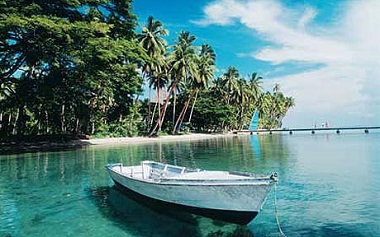Fiji's villagers move uphill to escape global warming's rising seas
 Fiji’s picturesque Natewa Bay must be a hard place to leave, and for none more so than the villagers of Vunidogoloa, who are preparing to abandon their ancestral home in the face of the rising sea. But they have little choice: big waves now overtop a once-protective sea wall, their salt-polluted vegetation is dying. They are to move as a community a mile inland, and uphill, to a new site on the northern island of Vanua Levu. Devout Methodists, they have named Kenani, Fijian for Canaan – the promised land.
Fiji’s picturesque Natewa Bay must be a hard place to leave, and for none more so than the villagers of Vunidogoloa, who are preparing to abandon their ancestral home in the face of the rising sea. But they have little choice: big waves now overtop a once-protective sea wall, their salt-polluted vegetation is dying. They are to move as a community a mile inland, and uphill, to a new site on the northern island of Vanua Levu. Devout Methodists, they have named Kenani, Fijian for Canaan – the promised land.The same thing is happening in the village of Narikoso on the small southern island of Oko, whose people took advantage by of a visit by the country’s prime minister two years ago to ask to move. They too are going uphill, a little more than half a mile, leaving, as one official put it, the place where “they have stored their history, their genealogy and their very being”.
Many villages in Fiji and throughout the Pacific Islands are similarly under siege from the encroaching waters. By 2050, according to some estimates, 650,000 of their people will have been forced to flee their homes as a result of climate change.
Diagonally across the Pacific, the villagers of Newtok, Alaska are also preparing to leave for higher ground, becoming the first US community to be forced to relocate, though in their case the problem is as much the instability of the ground beneath their feet, as global warming melts its permafrost. Some 180 Alaskan communities are similarly threatened by flooding and losing land.
Across the country the homes of 2.1 million people in Florida will be under water by the end of the century, while New York is expected to be flooded by disasters like Superstorm Sandy every two years. And, it is similarly predicted, America’s birthplace – Jamestown, Virginia, where Captain John Smith met Pocahontas – will be submerged by the year 2100.
Against this background, new estimates of likely sea-level rise have been produced this week by a group of top glaciologists and climate scientists. The bad news is that they are worse than the official projections of the Intergovernmental Panel on Climate Change (IPCC). The good is that they are less gloomy than projections made by the US Government’s National Oceanic and Atmospheric Administration (NOAA).
Mind you, almost any realistic estimate was going to project a higher rise than in the IPCC’s last major report, published in 2007, for it did only part of the job. It calculated that the thermal expansion of the oceans, as they warm up, would cause an average sea level rise of between 18 and 59cm. But, since it is an overwhelmingly cautious body, it did not add in the other great contributor – from the melting of the Greenland and Antarctic ice-sheets – because it reckoned it did not know enough about them. Now the new study has accounted for them as well, to produce a maximum of 27cm. That is very much lower than the two metres predicted by NOAA – though the scientists expect the increase to accelerate after the turn of the century.
Of course, it is an uncertain business – as evidenced by the wide range of the IPCC’s figures – and some scientists have already attacked the new study as too optimistic. But there is a growing consensus about what should be done, and it’s not just about curbing emissions of carbon dioxide, important though that is. Cutting short-lived climate pollutants like black carbon, methane and ozone – long a particular cause of mine – will be even more effective, another report conclude last month, largely because it is much quicker to take effect. But nothing, alas, can come fast enough to allow the people of Vunidogoloa to stay by the sea.
You can return to the main Market News page, or press the Back button on your browser.

